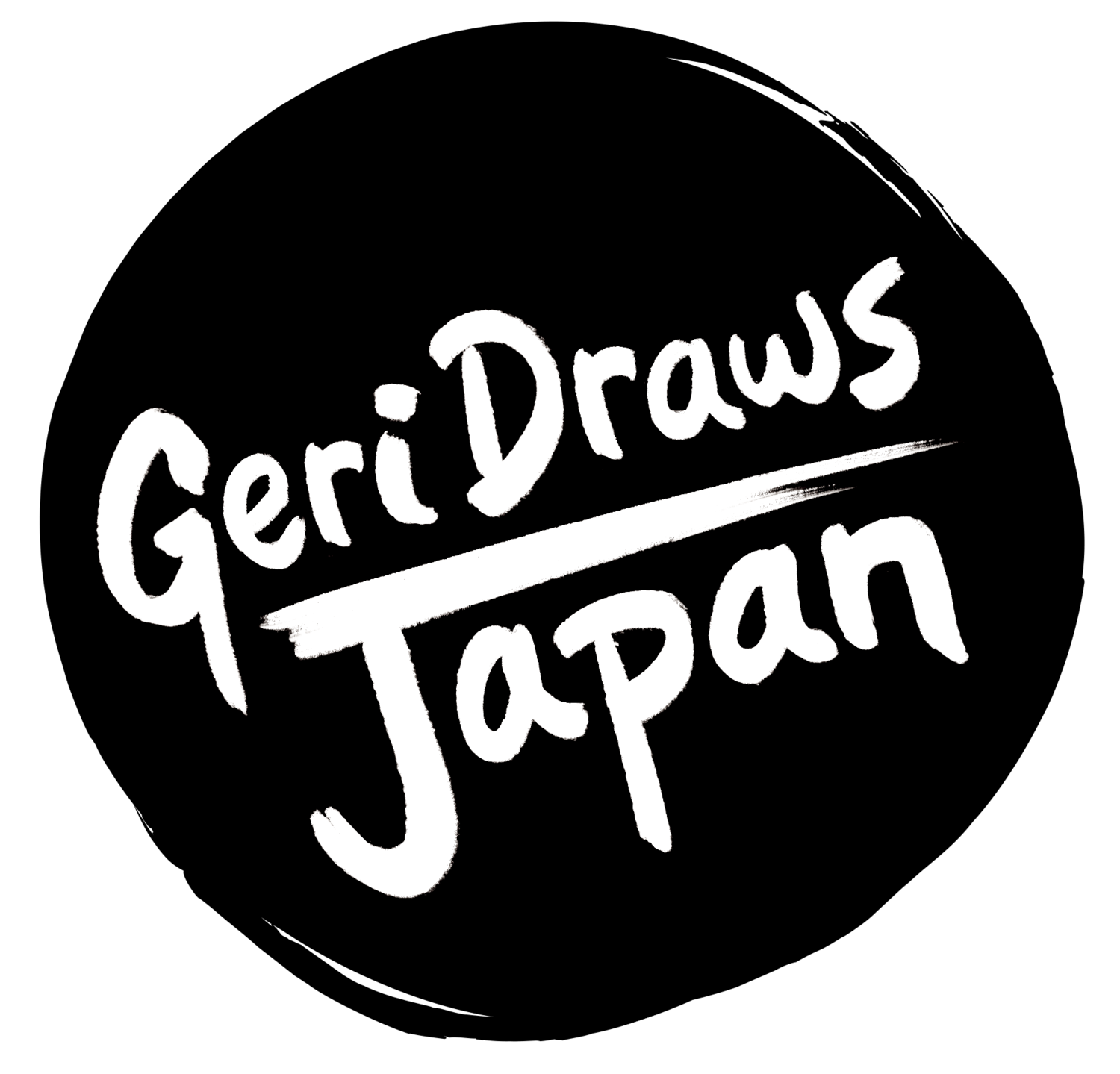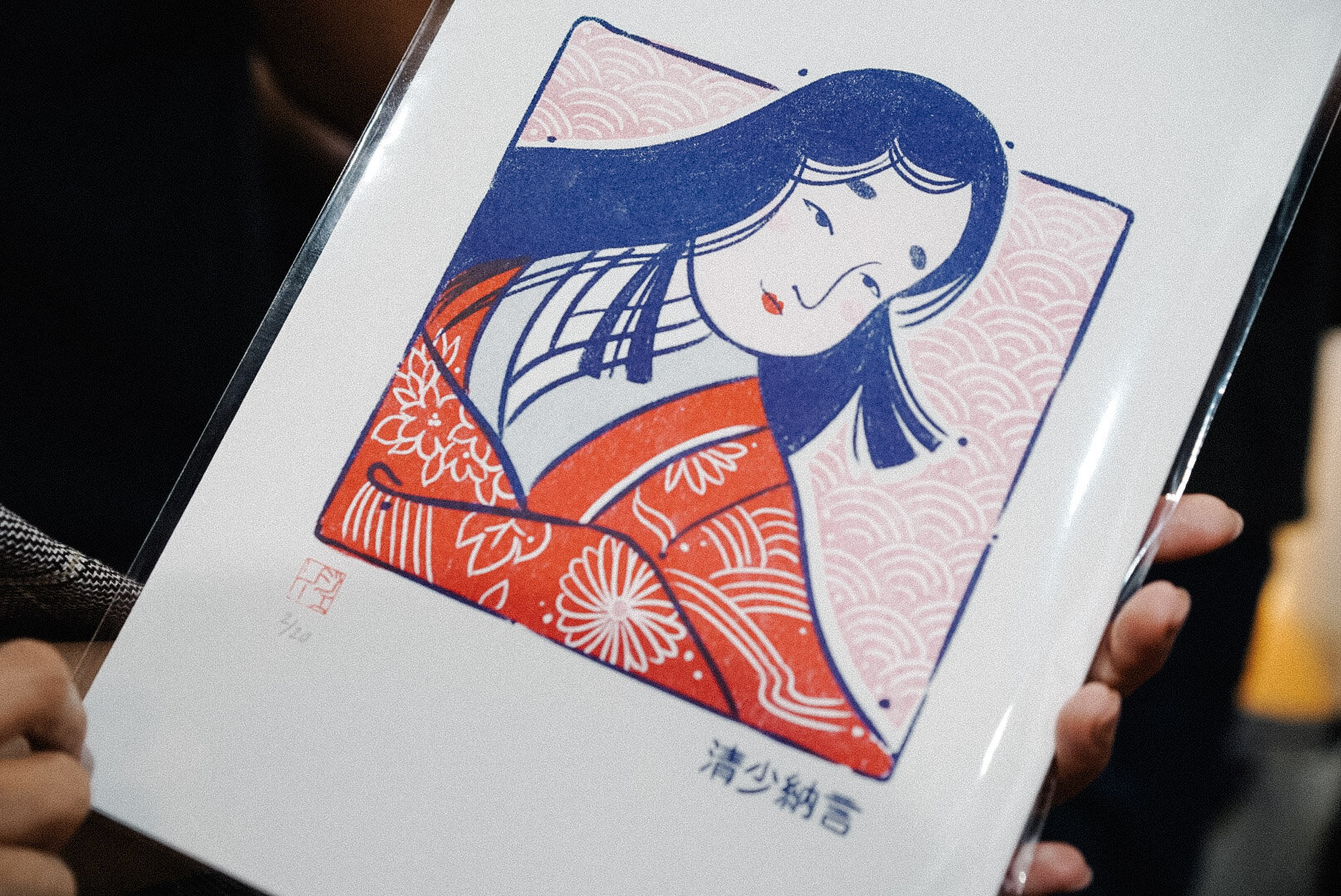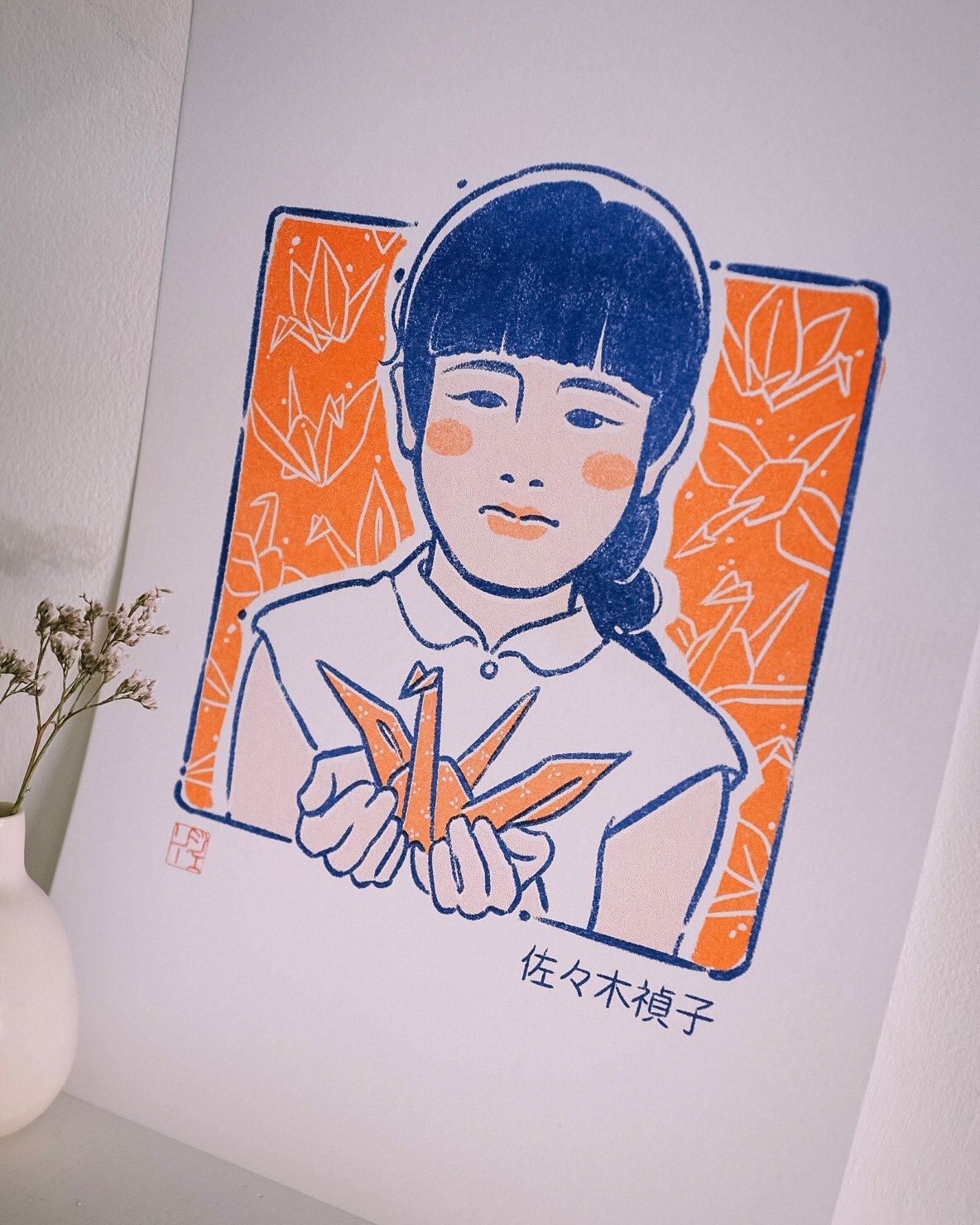Sasaki Sadako 佐々木禎子 - A4 Riso Print (Signed and Numbered)
I will be donating 100% of sales of this print to a charity called People in Need. This charity is working primarily in Donetsk and Luhansk to focus on distributing humanitarian aid to those most in need, providing decent livelihoods for internal refugees, as well as development cooperation in places affected by the war. To read more about the charity, please visit www.peopleinneed.net.
Sasaki Sadako 佐々木禎子
Child victim of nuclear warfare
原爆の被爆者、核戦争の犠牲者 (1943年1月7日–1955年10月25日)
彼女が爆破を生き延びたが、莫大な放射物による亜急性リンパ腺白血病になりました。
Sasaki Sadako was just two years old when the atomic bomb was dropped on Hiroshima on 6 August 1945. The bomb exploded near her home—just 1 mile from ground zero—and she was blown out of the window. Miraculously, her mother found her alive and without apparent injuries. Despite surviving the blast, ten years later Sadako developed acute leukaemia from the exposure to the intense radiation.
In 1955, when Sadako was hospitalised, her father recounted the legend of the paper cranes—the belief that anyone who folds 1000 would be granted a wish. In the hope that she would recover, she set out to meet her goal using any material she could get her hands on. She lacked paper at the hospital, so she used medicine wrappings, get-well present wrappings and asked other patients for materials, and her friends brought her paper from school.
A popular story in the West claimed that Sadako died before reaching her goal, however, her family confirmed that not only did she achieve her goal, but she continued to fold 300 more. She died at the age of 12 on 25 October 1955, in the company of friends and family. Today, statues of her are on display in the Hiroshima Peace Memorial Park and the Seattle Peace Park. She is one of the leading symbols of the impact of nuclear war.
What is a riso print?
These prints use risograph technology, a method of printing developed in Japan in the mid-1980s. It can be described as a mix between screenprinting and photocopying. The risograph process produces prints with extremely vibrant, crisp inks, and sometimes these inks overlap during the printing process to create interesting and unique details. These soy-based inks also have a lower environmental impact.
Product details
Printed in Tokyo, Japan by Hand Saw Press print studio. Each print is A4 size (210 x 297 mm / 8.27 x 11.69 in) and printed on Natural White 186gsm Takeo Araveal paper. Acid-free and FSC Approved.
Each print is signed with a traditional Japanese ‘hanko’ artist stamp and hand-numbered from a limited edition of 20. Prints are packaged in cello bags with rigid cardboard inserts and shipped in flat mailers.
Please note that frames are not included.
Delivery times & prices
We ship worldwide. 日本へ国際郵便で送ります。
UK deliveries: 3-4 working days via Royal Mail 1st class
International deliveries available via Royal Mail International Standard Airmail
Prices calculated during checkout
For more information on shipping times for international deliveries, please check the delivery & returns page.
I will be donating 100% of sales of this print to a charity called People in Need. This charity is working primarily in Donetsk and Luhansk to focus on distributing humanitarian aid to those most in need, providing decent livelihoods for internal refugees, as well as development cooperation in places affected by the war. To read more about the charity, please visit www.peopleinneed.net.
Sasaki Sadako 佐々木禎子
Child victim of nuclear warfare
原爆の被爆者、核戦争の犠牲者 (1943年1月7日–1955年10月25日)
彼女が爆破を生き延びたが、莫大な放射物による亜急性リンパ腺白血病になりました。
Sasaki Sadako was just two years old when the atomic bomb was dropped on Hiroshima on 6 August 1945. The bomb exploded near her home—just 1 mile from ground zero—and she was blown out of the window. Miraculously, her mother found her alive and without apparent injuries. Despite surviving the blast, ten years later Sadako developed acute leukaemia from the exposure to the intense radiation.
In 1955, when Sadako was hospitalised, her father recounted the legend of the paper cranes—the belief that anyone who folds 1000 would be granted a wish. In the hope that she would recover, she set out to meet her goal using any material she could get her hands on. She lacked paper at the hospital, so she used medicine wrappings, get-well present wrappings and asked other patients for materials, and her friends brought her paper from school.
A popular story in the West claimed that Sadako died before reaching her goal, however, her family confirmed that not only did she achieve her goal, but she continued to fold 300 more. She died at the age of 12 on 25 October 1955, in the company of friends and family. Today, statues of her are on display in the Hiroshima Peace Memorial Park and the Seattle Peace Park. She is one of the leading symbols of the impact of nuclear war.
What is a riso print?
These prints use risograph technology, a method of printing developed in Japan in the mid-1980s. It can be described as a mix between screenprinting and photocopying. The risograph process produces prints with extremely vibrant, crisp inks, and sometimes these inks overlap during the printing process to create interesting and unique details. These soy-based inks also have a lower environmental impact.
Product details
Printed in Tokyo, Japan by Hand Saw Press print studio. Each print is A4 size (210 x 297 mm / 8.27 x 11.69 in) and printed on Natural White 186gsm Takeo Araveal paper. Acid-free and FSC Approved.
Each print is signed with a traditional Japanese ‘hanko’ artist stamp and hand-numbered from a limited edition of 20. Prints are packaged in cello bags with rigid cardboard inserts and shipped in flat mailers.
Please note that frames are not included.
Delivery times & prices
We ship worldwide. 日本へ国際郵便で送ります。
UK deliveries: 3-4 working days via Royal Mail 1st class
International deliveries available via Royal Mail International Standard Airmail
Prices calculated during checkout
For more information on shipping times for international deliveries, please check the delivery & returns page.
I will be donating 100% of sales of this print to a charity called People in Need. This charity is working primarily in Donetsk and Luhansk to focus on distributing humanitarian aid to those most in need, providing decent livelihoods for internal refugees, as well as development cooperation in places affected by the war. To read more about the charity, please visit www.peopleinneed.net.
Sasaki Sadako 佐々木禎子
Child victim of nuclear warfare
原爆の被爆者、核戦争の犠牲者 (1943年1月7日–1955年10月25日)
彼女が爆破を生き延びたが、莫大な放射物による亜急性リンパ腺白血病になりました。
Sasaki Sadako was just two years old when the atomic bomb was dropped on Hiroshima on 6 August 1945. The bomb exploded near her home—just 1 mile from ground zero—and she was blown out of the window. Miraculously, her mother found her alive and without apparent injuries. Despite surviving the blast, ten years later Sadako developed acute leukaemia from the exposure to the intense radiation.
In 1955, when Sadako was hospitalised, her father recounted the legend of the paper cranes—the belief that anyone who folds 1000 would be granted a wish. In the hope that she would recover, she set out to meet her goal using any material she could get her hands on. She lacked paper at the hospital, so she used medicine wrappings, get-well present wrappings and asked other patients for materials, and her friends brought her paper from school.
A popular story in the West claimed that Sadako died before reaching her goal, however, her family confirmed that not only did she achieve her goal, but she continued to fold 300 more. She died at the age of 12 on 25 October 1955, in the company of friends and family. Today, statues of her are on display in the Hiroshima Peace Memorial Park and the Seattle Peace Park. She is one of the leading symbols of the impact of nuclear war.
What is a riso print?
These prints use risograph technology, a method of printing developed in Japan in the mid-1980s. It can be described as a mix between screenprinting and photocopying. The risograph process produces prints with extremely vibrant, crisp inks, and sometimes these inks overlap during the printing process to create interesting and unique details. These soy-based inks also have a lower environmental impact.
Product details
Printed in Tokyo, Japan by Hand Saw Press print studio. Each print is A4 size (210 x 297 mm / 8.27 x 11.69 in) and printed on Natural White 186gsm Takeo Araveal paper. Acid-free and FSC Approved.
Each print is signed with a traditional Japanese ‘hanko’ artist stamp and hand-numbered from a limited edition of 20. Prints are packaged in cello bags with rigid cardboard inserts and shipped in flat mailers.
Please note that frames are not included.
Delivery times & prices
We ship worldwide. 日本へ国際郵便で送ります。
UK deliveries: 3-4 working days via Royal Mail 1st class
International deliveries available via Royal Mail International Standard Airmail
Prices calculated during checkout
For more information on shipping times for international deliveries, please check the delivery & returns page.















